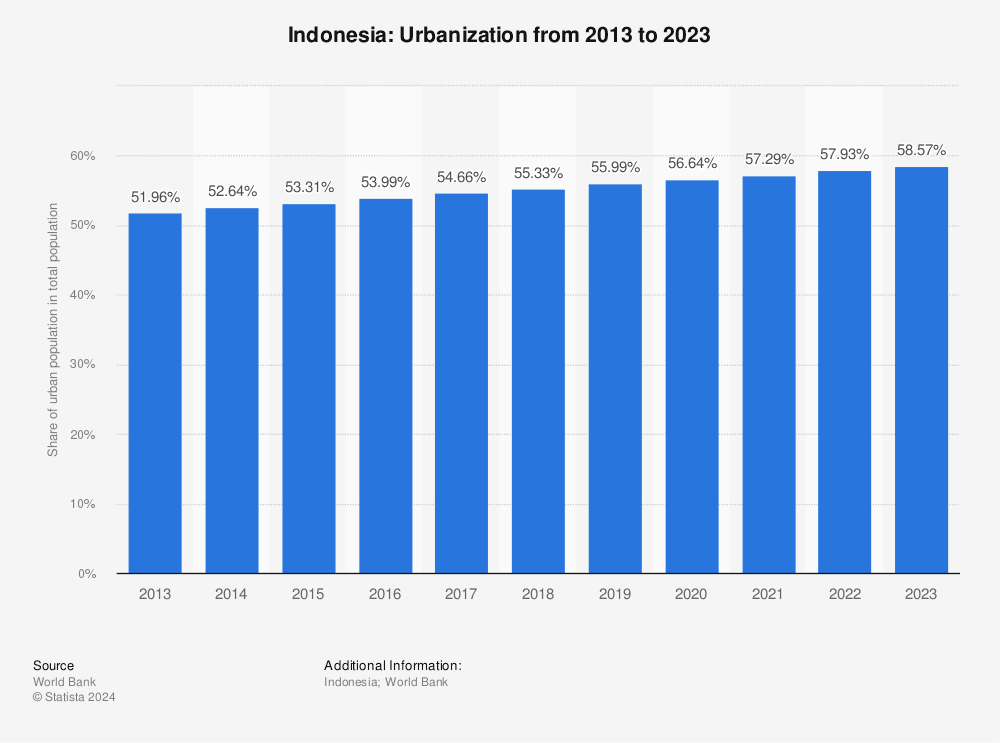Indonesia is undergoing rapid urbanization, transforming its construction sector into a powerhouse of growth and opportunity. With more people moving to cities, the demand for housing, transportation, and public infrastructure has surged, making Indonesia one of the most dynamic markets in Southeast Asia. This article will talk about how rapid Indonesia Urbanization and Construction Growth are creating significant opportunities in the construction market.
Indonesia Urbanization and Construction Growth Fuels Growth

As of 2023, 58.57% of Indonesia’s population lived in urban areas, a sharp rise from 53% in 2015. This trend is projected to continue, with urbanization expected to reach 68% by 2025. Such growth makes Indonesia one of the fastest-urbanizing countries globally, following only China and India in population shifts. Between 2010 and 2018, nearly 59 million people moved to urban areas, creating immense pressure—and opportunity—for cities to expand their housing and infrastructure.
The surge in Indonesia Urbanization and Construction Growth has a domino effect on the construction sector. In 2023, Indonesia’s construction industry was valued at USD 264.34 billion, with projections to reach USD 379.41 billion by 2028, growing at an impressive CAGR of 7.5%. This expansion reflects the country’s ability to capitalize on urbanization trends by investing in infrastructure and construction.
Government Investments: Paving the Way
The Indonesian government has embraced this urban boom, committing USD 500 billion to strategic infrastructure projects over its five-year development plan. These investments focus on improving urban and industrial infrastructure, fueling significant opportunities for construction companies and developers.
Key projects include the Jakarta-Bandung high-speed rail line, a groundbreaking initiative to reduce travel times and enhance national connectivity. Such developments are not only modernizing Indonesia’s transportation system but also bolstering the country’s economic potential by linking key urban centers more efficiently.
Opportunities in Housing and Public Infrastructure
Housing remains a crucial focus as Indonesia Urbanization and Construction Growth accelerate. To meet the rising demand, the government has introduced housing stimulus measures, such as VAT incentives for properties priced up to IDR 5 billion. These policies aim to make affordable housing more accessible, particularly for middle-income families in urban areas. The residential construction sector is poised for substantial growth, helping to address the housing shortages created by rapid population shifts.
Public infrastructure is another key area benefiting from the urbanization wave. With rising urban populations, the need for better roads, bridges, schools, and hospitals has intensified. Infrastructure improvements not only enhance living standards but also create jobs and spur economic activity, making the sector a cornerstone of Indonesia’s development strategy.
Transforming Indonesia Urbanization and Construction Growth Challenges
Indonesia Urbanization and Construction Growth bring challenges, such as overcrowding and the strain on public services. However, Indonesia’s proactive approach—supported by massive infrastructure investments—positions the country to turn these challenges into growth opportunities. By focusing on modern, sustainable urban development, Indonesia is setting the stage for long-term economic resilience.
The rapid Indonesia Urbanization and Construction Growth are reshaping its construction market, unlocking significant opportunities in housing, transportation, and infrastructure. With strong government support and a clear vision for the future, the country is not just keeping pace with urban growth but also thriving in it. As urbanization continues, Indonesia’s construction sector will remain a key driver of its economic success.

